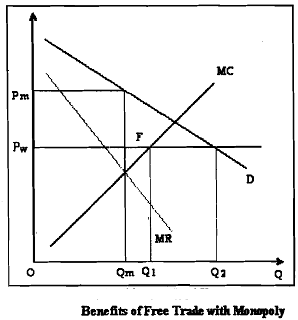Domestic Industry is a Monopoly:
When a monopolist controls the domestic industry X, the gains fiom trade can be illustrated using Figure. The monopolist faces the downward sloping demand curve D, while MC and MR are the monopolist's marginal cost and marginal revenue schedules respectively. In the situation before trade the equilibrium quantity, determined by the intersection of the MR and MC schedules is Qm and the corresponding price, read off the demand (or Average Revenue) schedule is Pm. As explained before consider a situation where the domestic country has a comparative disadvantage in the product of industry X. That is, the world price Pw is lower than Pm so the good is imported.
When trade is opened up, imports become available at the world price Pw. So in the post-trade scenario the monopolist cannot charge a price higher than Pw , which now provides an upper bound for the price that can be charged in the domestic market.
Thus with fiee trade the monopoly equilibrium shifts to F. At the post-trade price Pw, total domestic demand is OQ2, of which OQ1 amount is supplied by the domestic monopolist and Q1Q2 amount is imported.

Before trade the price of the good in the domestic market Pm was higher than marginal cost. However, opening up trade lowers the domestic price and in the post-trade equilibrium F, the price Pw is equal to marginal cost. Therefore social welfare is clearly higher in the post- trade situation as international competition has served to limit the monopolists' price- setting power and moved the economy to the competitive equilibrium.
In this context additional gains hm trade can arise through a reduction of X-inefficiency, if competitive pressures induce the monopolist to become a more efficient producer.